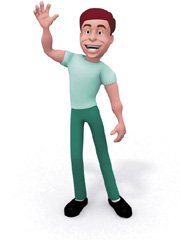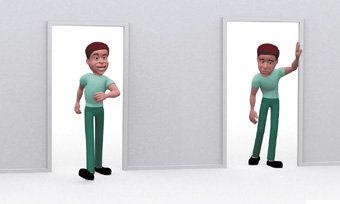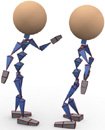Acting Technique
Once you understand your character, you need to put that knowledge into action by acting and performing the character. Acting is an art form, and like any other art form, it has a number of core techniques. These techniques, however, are only the tip of the icebergas with any art form, the deeper you explore, the more there is to learn.
Creating Empathy
The big goal of an animator, as well as of the writers, is to create empathy for the character. Empathy means that the audience emotionally connects with the character on some level and identifies with him. This is not to be confused with sympathy, where the audience simply feels sorry for someone. When a character evokes sympathy, members of the audience say, "I pity that guy." When the audience feels empathy, however, they can say, "I know how that guy feels; I've been there myself." A character who evokes empathy plays to the heart.
Say that you need to animate the oldest gag in the book: a character slipping on a banana peel. You can have the character's feet fly out from under him and have him land on his rear end, then get up and move along. Pretty boring, and the audience will not feel much empathy for the character.
Instead, try to bring out your character by showing a side of his personality to the audience. This enables the audience to go beyond simply viewing the action to feeling what your character is feeling. If the character is an extremely dignified person, he might get up quickly and look around to make sure he didn't embarrass himself in front of others. If the character is starving to death, perhaps he'll pull the banana peel off the bottom of his shoe and eat it, turning an unfortunate incident into a humorous blessing.
Villains also need to generate empathy. How many times have you seen a cartoon in which the villain was completely evil, with no redeeming qualities? These villains are usually two-dimensional and not very interesting. Just like the hero, villains need to get the audience on their side. The scariest villains are the ones who appear real to the audience. A good villain is really just a character with a few fatal flaws. The evil character will still want many of the things normal people want, but his priorities are skewed. Darth Vader is a classic villain, yet he still wants his son Luke to follow in his footstepsjust as many fathers do.
Think of Kathy Bates in Misery. She created a very real and very scary character. Most people know someone who is a big fan of an actor, a TV series, a movie, or the characters in a series of books, as in this case. When Kathy Bates's character learns that an author (played by James Caan) is essentially going to kill her favorite book series (along with its characters), she does what she must to protect them. She detains James Caan's character and forces him to keep them alive by writing more books. It's almost as though it's her motherly duty to protect those characters. Even though her measures are extreme, the audience identifies with her, as both an ardent fan and a protective mother.
When you animate, try to get the audience to understand your character and what it is feeling. Go beyond the actions to dig deep into the character's personality and find actions that define your character.
Creating Inspiration
Animation is performing, and a good performance is an inspired performance. One starting point for creating inspiration is a concept the great acting coach Stanislavski (the originator of the modern style of realistic acting) described as the "magic if." The "magic if" asks the question "What would I do if I were in these circumstances?"
The answer to this simple question can be a springboard to creativity and inspiration. As an animator you get the chance to be someone else for the daya fictional character, a cartoon. In a true cartoon world, what would you do if you had an anvil dropped on your head? For the cartoon character, this sort of stuff happens all the time and is perfectly normal. When you put yourself totally in the character's environment and circumstances, it inspires you.
In many respects, this technique is a lot like play-acting. A child truly believes her doll is real. It is the job of animators to make the digital props and sets real to themselves. By using the "magic if," animators grant themselves permission to "believe" in these imaginary objects.
In a true cartoon world, what would you do if you had an anvil dropped on your head? When you put yourself totally in the character's environment, it inspires you.

Creating Movement
Until a character moves, it is nothing but a nicely modeled mannequin. Animating a character and bringing it to life requires that you move it. The first thing a novice animator does is start moving body parts around to see what happens. This trial and error approach can have its moments, but a professional animator needs a much larger arsenal. First, you need to understand that characters always move for a reason. Those reasons are almost always emotionally driven. You cannot "will" emotions. In life, emotions result from stimuli, which affect the character's senses and evoke an emotional response.
The emotions the character feels dictate the type and quality of the motion: a sad character moves much differently than a happy one, for example. Being able to convey a character's emotions through motion is what makes an animator great.
Most of the time, people do not think about the individual actions they perform. When you walk, you don't usually think about placing one foot in front of anotherif you're in love, for example, you're thinking about your lover while you happen to be walking. The emotions dictate the character of the walking motions. When a comedian tells a joke, you laugh; you do not think, "Now I'm going to laugh." This is the key to good animation. Your character's movements need to be unforced and natural.
Different emotions cause a character to move differently.

The best way to animate this sort of natural motion is to try to block out your poses quickly and develop a creative flow. You can do this by using a fast and easily manipulable rig, pulling up stored poses, or simply thumbnailing the poses on paper. When you are truly acting, you are not really thinking about the individual motions, and the same should happen when you start animating. As things start to flow creatively, each pose just happens as a consequence of the emotions your character is feeling. Once you've blocked these basic poses out, you can switch your brain over to a more technical mind-set and critically analyze your poses as well as animate the inbetweens and finalize the animation.
Cause and Effect
A story is a sequence of events. Each event has an effect on the next. Cause and effect, therefore, drive both the story and the way a character is animated.
The cause can be any sort of action, from a force of nature to the actions of another character. The effect is how your character deals with those actions. Your character smells smokehe looks around for flames. Your character sees a bully walking down the streethe decides to turn in the other direction. Your character hears funky musiche starts dancing. In some cases, the causes are filtered through the senses: a character smells smoke, sees a bully, hears music, and then reacts.
In other situations, the cause of an action is internal, perhaps drawn from a memory. A character recalls a pleasant childhood moment and smiles. A starving character remembers the taste of apple pie and his mouth waters. In these cases, the eyes still matter. A character remembering something always moves its eyes as it searches for the memory.
The character smells smoke, and then reacts.

As a character searches its memory, the eyes follow along.

Object of Attention
As we move through the day, our attention shifts from place to place, from object to object. Things happen. Those things demand attention.
Right now, your attention is focused on this book. You're exercising only those parts of the body that are used for reading. The rest of your body is relaxed. If the telephone were suddenly to ring, your attention would shift away from this book to the telephone. You would then exercise those parts of the body needed to travel to the phone and pick up the receiver. You would forget about the book momentarily as you focused completely on the phone.
Lee Strasberg, the father of method acting, would say that, in this case, the individual's object of attention has changed from the book to the phone. The object of attention is a basic building block with which both actors and animators work. By having the character concentrate on the object representing the task at hand, the animator establishes a sense that the character is truly involved in what he is doing.
When a cat plays with a catnip toy in the kitchen, it uses only those muscles necessary to concentrate on the object of attention: the toy. The cat is simply trying to accomplish a specific "task": to conquer the toy. All other muscles are completely relaxed.
When the character is reading a book, he's exercising only those parts of the body that are used for reading. When the phone rings, the character's attention shifts completely to the phone. He momentarily forgets about the book.

If the dog dashes into the kitchen looking for a drink, the cat's body suddenly changes its demeanor as it focuses on the new object of attention: the dog. The cat may tense up and arch its back, but it still uses only those muscles necessary to concentrate on its new object of attention. The cat's task has changed and she has momentarily forgotten the toy; her new task is to put the dog in its place.
The dog's object of attention, which had been "water," now becomes "the cat," and his original objective to "drink water" now becomes "growl at the cat." The dog is using only those muscles necessary to accomplish this task. He is focused on the cat, not the water.
Clarity
Making your character 100 percent focused on the task at hand gives your performance clarity. The audience knows exactly what the character is thinking at any given moment. Even when a character is distracted momentarily, it focuses 100 percent of its attention on the distraction for that fleeting moment.
Take the dog and cat situation a step further. Perhaps the dog becomes indecisive. He really needs that drink but still has to deal with the pesky cat. If you split the difference, the dog focuses 50 percent of the way between the cat and the water. The audience then wonders, "Why is the dog staring into space?"
The dog really needs that cool drink...

...but it also needs to deal with the cat. Even when your character cannot make up its mind, it is fully focused on one possibility or the other.

Even in its indecision, the dog needs to switch between objects of attention: 100 percent on the water, 100 percent on the cat. He looks longingly at the water, then turns back to growl at the cat. When he is looking at the water, he can really imagine that cool drink. When he is facing the cat, he is totally absorbed in that task.
If your character is 100 percent focused in the scene, the performance is crystal clear. If the character is not focused, the performance is muddy. Even when your character cannot make up its mind, it is fully focused on one possibility or the other.
Simplicity
Another way to achieve clarity is through simplicity. An old animation adage is "one thing at a time." This is similar to the concept of attention, but it also helps clarify the individual actions. A character trips, then falls, then gets upit doesn't do them all at once.
You also should be clear as to what the individual action represents. Don't animate angerthat's too broad and general. What is the focus of the anger? It's better to animate "I hate my boss." This simplifies the emotion as well as gives your character focus. To give the emotion more depth, add the survival objective "I am angry at my boss, but I need my job to survive." This adds even more depth to the emotion so that the audience can truly empathize with the character.
In addition, try to simplify each of your character's poses and actions to keep them as clear as possible. The actions are like the links of a chain. They all fit together sequentially. If each action is clear and easily read, that link of the chain is strong. An overly complex pose or action could possibly break the chain and lose the audience.
Keep your poses simple and direct.

The Moment Before
One aspect of a character that is often overlooked is what the character was doing just before the scene started. Imagine a character entering a locker room. Is the character coming in off the street? Coming back from a heavy workout? Returning from a losing game? Each of these situations affects how the character carries itself when it enters the scene. Knowing what happened in the moments before this moment helps you keep your character focused.
As the character walks in the door, he conveys to the audience what happened the moment before.

Character Status
When animating multiple characters in a scene, you need to determine their status in relation to one another. Understanding who is "top dog," so to speak, helps tremendously in guiding the interactions between your characters.
A servant always defers to the master. In politics, everyone is expected to stand when the President walks into the room. A drill sergeant dominates his recruits. These are all extreme examples, but status is important in any society, and it translates to every aspect of our dealings with others, no matter how subtle. One character is always more dominant, and others are more submissive.
Which character has the higher status?

There is also a status transaction that happens regardless of rank and file and has to do with who is commanding the scene at the time. If you handle your poses in a way that clearly illustrates who is in control of the scene, the emotions will be more easily read. An example would be a man proposing marriage to a woman. He is in control of the scene when proposing, and then she is in control with her response. One is not necessarily higher than the other in a sense of society or rank and file, but each has a command of the scene at different times.
Status is displayed through body posture. The character with the higher status usually stands tall and projects his energy outward with a steady gaze. A submissive character leans forward and gazes down, sending his energy toward the floor.
Another clue to status and/or dominance can be illustrated using a technique called "mirroring." The submissive character will copy or mirror the dominant character's actions. This should appear to be a subconscious action on the character's part and is very subtle.
Givens
Whenever you work with a character, certain things are "given" to you to work with. These are the things you cannot change about the character. You may or may not agree with some of the decisions made before you took control of the character, but you need to accept these givens and use them to your advantage.
Voice recordings are one of the biggest givens for the animator. Typically, this is positive, because a good voice performance is an excellent foundation from which to build convincing animation. Big conflicts can arise, however, when an animator doesn't agree with the voicing of the character.
Other givens include the design of the character, the virtual sets, and other constraints. If you are integrating a character with live action, you may have to go so far as to match your character's movements with that of a live-action actor.
With any of these givens, the trick is to use them to your advantage. Working with the director may help to clarify the choices that were made before the work got to you. The cleverest choices often arise from limitations.
Chapter One. Basics of Character Design
- Chapter One. Basics of Character Design
- Approaching Design as an Artist
- Design Styles
- Designing a Character
- Finalizing Your Design
Chapter Two. Modeling Characters
Chapter Three. Rigging Characters
- Chapter Three. Rigging Characters
- Hierarchies and Character Animation
- Facial Rigging
- Mesh Deformation
- Refining Rigs
- Conclusion
Chapter Four. Basics of Animation
- Chapter Four. Basics of Animation
- Understanding Motion
- Animation Interfaces
- The Language of Movement
- Secondary Action
- Conclusion
Chapter Five. Creating Strong Poses
- Chapter Five. Creating Strong Poses
- Posing the Body Naturally
- Creating Appealing Poses
- Animating with Poses
- Conclusion
Chapter Six. Walking and Locomotion
- Chapter Six. Walking and Locomotion
- The Mechanics of Walking
- Animating Walks
- Beyond Walking
- Adding Personality to a Walk
- Transitions
- Conclusion
Chapter Seven. Facial and Dialogue Animation
Chapter Eight. Animal Motion
Chapter Nine. Acting
- Chapter Nine. Acting
- Acting Vs. Animating
- Acting and Story
- Acting Technique
- Acting and the Body
- Other Techniques
- Conclusion
Chapter Ten. Directing and Filmmaking
EAN: 2147483647
Pages: 84
